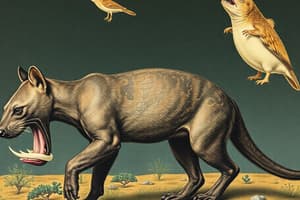Podcast
Questions and Answers
What is the main distinction between most plants and most animals in terms of body structure?
What is the main distinction between most plants and most animals in terms of body structure?
- Animals rely on photosynthesis, while plants rely on chemosynthesis for energy production.
- Animals have more variation in shapes and sizes, while plants have more definite form and sizes.
- Plants have more variation in shapes and sizes, while animals have more definite form and sizes. (correct)
- Plants rely on photosynthesis, while animals rely on chemosynthesis for energy production.
What is the chief food-making process in plants?
What is the chief food-making process in plants?
- Insect-trapping
- Chemosynthesis
- Photosynthesis (correct)
- Autotrophy
Which term is a more accepted way to describe the feeding behavior of 'carnivorous' plants like the pitcher plant?
Which term is a more accepted way to describe the feeding behavior of 'carnivorous' plants like the pitcher plant?
- Insect-trapping (correct)
- Photosynthesis
- Chemosynthesis
- Autotrophy
What is the source of energy for chemosynthesis in hydrothermal vents?
What is the source of energy for chemosynthesis in hydrothermal vents?
In which process are energy from the environment converted into food energy stored in carbohydrates?
In which process are energy from the environment converted into food energy stored in carbohydrates?
Which statement accurately describes the role of 'carnivorous' plants like the pitcher plant in their nutrient uptake?
Which statement accurately describes the role of 'carnivorous' plants like the pitcher plant in their nutrient uptake?
In plant cells, what is the non-living enclosure that is chiefly made of cellulose?
In plant cells, what is the non-living enclosure that is chiefly made of cellulose?
Which organelle is absent in plant cells but present in animal cells and serves as chromosome orientation poles during cell division?
Which organelle is absent in plant cells but present in animal cells and serves as chromosome orientation poles during cell division?
What is the primary storage form of carbohydrates in plant cells?
What is the primary storage form of carbohydrates in plant cells?
During respiration, what gas do plants take in and what gas do they release?
During respiration, what gas do plants take in and what gas do they release?
Which process allows a starfish to replace a lost arm or a newt to regenerate feet, eyes, and tail?
Which process allows a starfish to replace a lost arm or a newt to regenerate feet, eyes, and tail?
Which structure is characteristic of animal cells but absent in plant cells and is responsible for intracellular digestion?
Which structure is characteristic of animal cells but absent in plant cells and is responsible for intracellular digestion?
What is the main role of meristems in plants?
What is the main role of meristems in plants?
During embryonic development in animals, what do embryonic tissues develop into?
During embryonic development in animals, what do embryonic tissues develop into?
What distinguishes animal cells from plant cells regarding the presence of cell walls?
What distinguishes animal cells from plant cells regarding the presence of cell walls?
What limits animal growth compared to plant growth?
What limits animal growth compared to plant growth?
Flashcards
Plant vs. Animal Body Structure
Plant vs. Animal Body Structure
Plants exhibit a wide range of shapes and sizes, while animals tend to have more defined forms and sizes.
Photosynthesis
Photosynthesis
Photosynthesis is the process plants use to convert light energy from the sun into chemical energy stored in carbohydrates.
Insect-Trapping Plants
Insect-Trapping Plants
Instead of 'carnivorous,' insect-trapping is a more accurate term for plants like the pitcher plant that capture insects for nutrients.
Chemosynthesis
Chemosynthesis
Signup and view all the flashcards
Energy Conversion in Plants
Energy Conversion in Plants
Signup and view all the flashcards
Nutrient Uptake in Insect-Trapping Plants
Nutrient Uptake in Insect-Trapping Plants
Signup and view all the flashcards
Plant Cell Wall
Plant Cell Wall
Signup and view all the flashcards
Centrioles: Plant vs. Animal
Centrioles: Plant vs. Animal
Signup and view all the flashcards
Starch in Plants
Starch in Plants
Signup and view all the flashcards
Plant Respiration
Plant Respiration
Signup and view all the flashcards
Regeneration
Regeneration
Signup and view all the flashcards
Lysosomes: Plant vs. Animal
Lysosomes: Plant vs. Animal
Signup and view all the flashcards
Meristems in Plants
Meristems in Plants
Signup and view all the flashcards
Embryonic Development in Animals
Embryonic Development in Animals
Signup and view all the flashcards
Cell Walls: Plants vs. Animals
Cell Walls: Plants vs. Animals
Signup and view all the flashcards
Growth Limitation in Animals
Growth Limitation in Animals
Signup and view all the flashcards




